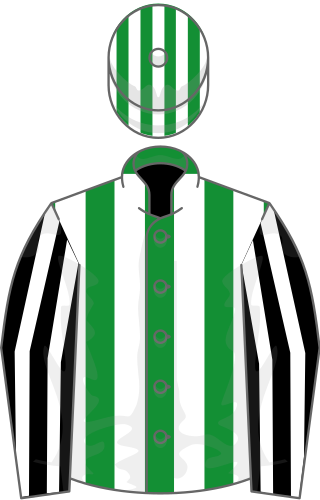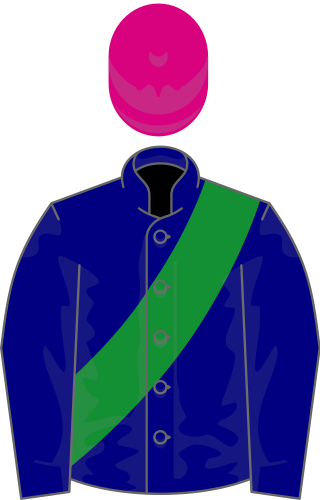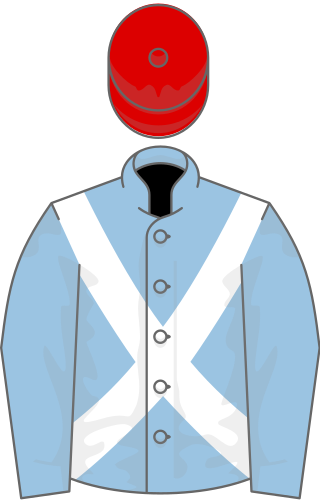Related Research Articles

The Grand National is a National Hunt horse race held annually at Aintree Racecourse, Aintree, Merseyside, England. First run in 1839, it is a handicap steeplechase over an official distance of about 4 miles and 2½ furlongs, with horses jumping 30 fences over two laps. It is the most valuable jump race in Europe, with a prize fund of £1 million in 2017. An event that is prominent in British culture, the race is popular amongst many people who do not normally watch or bet on horse racing at other times of the year.
In horse racing in the United Kingdom, France and Republic of Ireland, National Hunt racing requires horses to jump fences and ditches. National Hunt racing in the UK is informally known as "jumps" and is divided into two major distinct branches: hurdles and steeplechases. Alongside these there are "bumpers", which are National Hunt flat races. In a hurdles race, the horses jump over obstacles called hurdles; in a steeplechase the horses jump over a variety of obstacles that can include plain fences, water jump or an open ditch. In the UK, the biggest National Hunt events of the year are generally considered to be the Grand National and the Cheltenham Gold Cup.

Aintree Racecourse is a racecourse in Aintree, Metropolitan Borough of Sefton, Merseyside, England, bordering the city of Liverpool. The racecourse is the venue for the Grand National steeplechase, which takes place annually in April over three days. Aintree also holds meetings in May and June, October (Sunday), November and December.

Red Rum was an Irish champion Thoroughbred steeplechaser. He achieved an unmatched historic treble when he won the Grand National in 1973, 1974 and 1977, and also came second in the two intervening years, 1975 and 1976. The Grand National is a notoriously difficult race that has been described as "the ultimate test of a horse’s courage". He was also renowned for his jumping ability, having not fallen in 100 races.

Desert Orchid, known as Dessie, was an English racehorse. The grey achieved a revered and esteemed status within National Hunt racing, where he was much loved by supporters for his front-running attacking style, iron will and extreme versatility. He was rated the fifth-best National Hunt horse of all time by Timeform. During his racing career he was partnered by five different jump jockeys: Colin Brown, Richard Linley, Simon Sherwood, Graham Bradley and Richard Dunwoody.

The 2000 Grand National was the 153rd official renewal of the Grand National steeplechase that took place at Aintree Racecourse in England on 8 April 2000.

Burrough Hill Lad (1976–2004) was a British Thoroughbred racehorse. Named after Leicestershire village Burrough-On-The-Hill, he competed in National Hunt races and won seventeen times from twenty-seven runs in steeplechases. His performances in 1984, when he won the Cheltenham Gold Cup, Hennessy Gold Cup and King George VI Chase saw him rated one of the best horses in the history of the sport.

L’Escargot (1963–1984) was an Irish national hunt racehorse notable as being a Cheltenham Gold Cup and Grand National winner.

The 1997 Grand National was the 150th official running of the Grand National steeplechase held at Aintree near Liverpool. The race was scheduled to be run on Saturday 5 April 1997, but was postponed by two days to Monday 7 April after a Provisional Irish Republican Army (IRA) bomb threat forced the evacuation of the course.

The 1994 Grand National was the 147th official renewal of the Grand National horse race that took place at Aintree near Liverpool, England, on 9 April 1994.

The 1996 Grand National was the 149th official renewal of the world-famous Grand National steeplechase that took place at Aintree on 30 March 1996.It was the first national to run since 3 time winner Red Rum was buried at the winning post following his death the previous October.

The 1995 Grand National was the 148th official renewal of the famous Grand National steeplechase that took place at Aintree near Liverpool, England, on 8 April 1995.
The 1973 Grand National was the 127th renewal of the Grand National horse race that took place at the Aintree Racecourse near Liverpool, England, on 31 March 1973.
The 1977 Grand National was the 131st renewal of the Grand National horse race that took place at Aintree Racecourse near Liverpool, England, on 2 April 1977.
The 1967 Grand National was the 121st renewal of the world-famous Grand National steeplechase that took place at Aintree Racecourse near Liverpool, England, on 8 April 1967. The race is best remembered for being won by outsider Foinavon at odds of 100/1, after being the only horse to avoid a mêlée at the 23rd fence and jump it at the first attempt.

The 1991 Grand National was the 145th renewal of the Grand National horse race that took place at Aintree Racecourse near Liverpool, England, on, on 6 April 1991.

The 1987 Grand National was the 141st running of the Grand National horse race that took place at Aintree Racecourse near Liverpool, England, on 4 April 1987.
Auroras Encore is an Irish-bred, British-trained Thoroughbred racehorse best known for winning the 2013 Grand National. In a racing career which lasted from February 2007 until January 2014 he won two hurdle races and six steeplechases from forty-seven starts.

Many Clouds was an Irish-bred, British-trained Thoroughbred racehorse best known for winning the 2015 Grand National. After being sold as a foal, he was sent to England and trained for a National Hunt racing career by Oliver Sherwood.

Tiger Roll is a retired Irish-bred Thoroughbred racehorse who competed in National Hunt racing and won the Grand National in 2018 and 2019. He has also won five times at the Cheltenham Festival: the Triumph Hurdle in 2014, the National Hunt Chase Challenge Cup in 2017 and the Glenfarclas Cross Country Chase in 2018, 2019 and 2021.
References
- 1 2 3 4 "Racing: Richard Pitman 'Ride of my life' burns bright in Pitman memory". The Independent . 5 April 2003. Archived from the original on 23 September 2010.
- 1 2 "'He might not have won - but 1973 will always be remembered as Crisp's National'". Racing Post . 1 July 2022.
- ↑ "The story of Crisp, whose heroic defeat at the '73 Grand National helped tee up the legend of Red Rum". The Telegraph . 12 March 2021.
- ↑ "McGrath's memorable Nationals". BBC Sport. 2 April 2003.